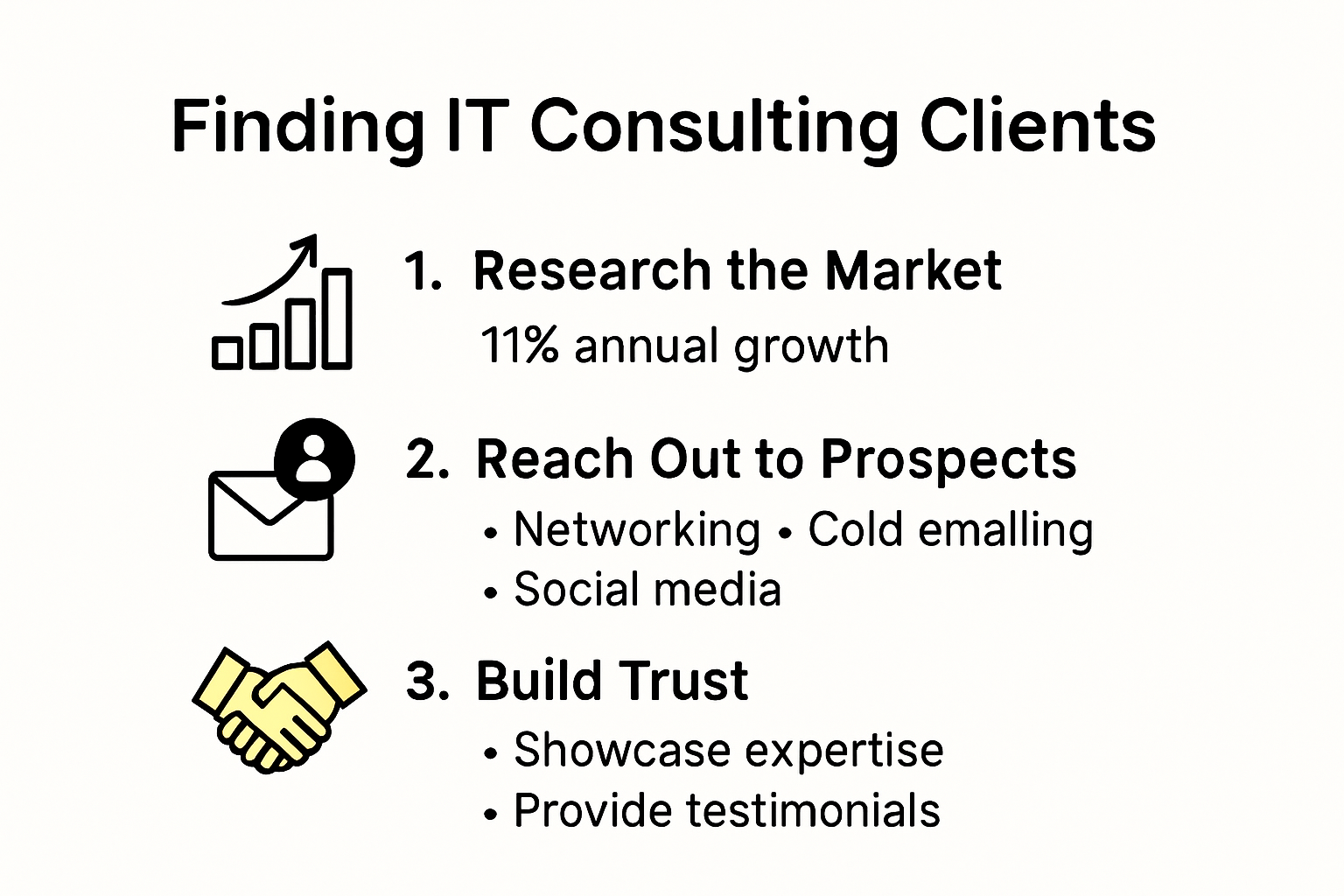Finding Consulting Clients: A 2025 Guide for IT Professionals
- Carlos Perez Alviarez

- Jul 11
- 9 min read
Updated: Jul 19

Finding IT consulting clients is top of mind for many looking to grow in 2025. Here is something you may not expect. While most people are chasing the latest tech, the real edge comes from understanding just how massive this market has become with the global IT consulting sector projected to hit 114.01 billion dollars in 2024. That means those who focus on connecting with people and building trust are often the ones landing the best contracts.
Table of Contents
Quick Summary
Takeaway | Explanation |
Market Growth Opportunities | The global IT consulting market is projected to grow from $104.88 billion in 2023 to $114.01 billion in 2024, making it crucial for IT professionals to identify and target industries, such as healthcare and financial services, that are primed for consulting services. |
Strategic Digital Networking | Leveraging platforms like LinkedIn for personalized outreach and content sharing can increase visibility and engagement rates, enhancing client acquisition efforts by introducing oneself as a valuable partner. |
Building Online Trust | Developing a compelling digital identity through a professional website, showcasing client testimonials, and sharing thought leadership content establishes credibility and attracts potential clients. |
Engagement in Local Networks | Actively participating in professional associations and events can create direct connections with potential clients, while referral programs can build a robust ecosystem for generating new business opportunities. |
Leveraging Predictive Insights | Utilizing analytics to anticipate client needs and crafting tailored communication strategies based on market intelligence can position IT consultants as proactive and insightful partners in solving technological challenges. |

Understanding the IT Consulting Client Landscape
The IT consulting market represents a dynamic and rapidly evolving professional ecosystem where technological expertise meets strategic business transformation. As digital technologies continue to reshape industries, understanding the nuanced landscape of potential consulting clients becomes crucial for IT professionals seeking sustainable and profitable engagements.
Market Dynamics and Growth Potential
The global IT consulting market demonstrates remarkable growth trajectory, with research from Research and Markets projecting the market to expand from $104.88 billion in 2023 to $114.01 billion in 2024, representing a compound annual growth rate of 8.7%. This substantial growth signals significant opportunities for IT professionals positioned to deliver targeted consulting services.
Moreover, market analysis from Wise Guy Reports reveals that the IT consulting services market is expected to reach an impressive $591.59 billion in 2024, with technology consulting accounting for approximately $180.51 billion. These figures underscore the critical role consultants play in driving technological innovation and business transformation across various sectors.
Here is a table summarizing key market statistics mentioned for quick reference:
Year | Overall Global IT Consulting Market | IT Consulting Services Market | Technology Consulting Segment |
2023 | $104.88 billion | - | - |
2024 | $114.01 billion | $591.59 billion | $180.51 billion |
Identifying Potential Client Segments
Successful IT consulting requires a strategic approach to identifying and targeting client segments most likely to require specialized expertise. Key industries presenting robust consulting opportunities include:
Healthcare Technology: Organizations seeking digital transformation and cybersecurity enhancements
Financial Services: Institutions requiring technological modernization and regulatory compliance solutions
Manufacturing: Companies implementing IoT, automation, and advanced analytics strategies
Retail and E-commerce: Businesses looking to optimize digital infrastructure and customer experience platforms
These sectors consistently demonstrate high demand for specialized IT consulting services, offering IT professionals multiple avenues for client acquisition. Learn more about developing your consulting strategy to effectively target these lucrative markets.

Regional Market Considerations
Geographic variations play a significant role in IT consulting opportunities. Analysis from ZipDo indicates that the North American IT consulting market experienced an 8% growth in 2023, with Europe accounting for approximately 22% of the global market share. These regional differences suggest that IT professionals must adapt their strategies to local market conditions and technological ecosystems.
Below is a table summarizing regional market statistics for the IT consulting sector:
Region | 2023 Growth Rate | 2023 Market Share |
North America | 8% | - |
Europe | - | ~22% |
Understanding client needs goes beyond technical capabilities. Successful IT consultants recognize that clients seek partners who can translate complex technological solutions into tangible business value. This requires a holistic approach that combines technical expertise with strategic thinking, communication skills, and a deep understanding of industry-specific challenges.
Navigating the IT consulting client landscape demands continuous learning, adaptability, and a proactive approach to identifying emerging technological trends and client pain points. By maintaining a comprehensive view of market dynamics, IT professionals can position themselves as indispensable strategic partners rather than mere service providers.
Proactive Outreach Strategies That Work
Successful IT consulting demands more than technical expertise. It requires strategic, intentional approaches to connecting with potential clients and demonstrating value before they even recognize their need for consulting services.
Leveraging Digital Networking Platforms
Digital networking has transformed client acquisition strategies for IT consultants. Personalized outreach on professional platforms like LinkedIn can significantly enhance visibility and credibility. Research from Alleo indicates that implementing targeted email sequences can improve engagement rates by up to 35%.
Successful digital networking involves:
Strategic Profile Optimization: Crafting a compelling professional narrative that highlights specialized expertise
Consistent Content Creation: Sharing industry insights, case studies, and technological perspectives
Targeted Connection Requests: Connecting with decision makers in relevant industries
Engagement Through Meaningful Interactions: Commenting, sharing, and providing value before direct outreach
Predictive Client Intelligence
Advanced analytics platforms now enable consultants to move beyond traditional reactive approaches. By utilizing predictive modeling and market intelligence, IT professionals can anticipate client needs before they become apparent.
This proactive approach involves:
Monitoring industry trends and technological shifts
Analyzing company public data for potential transformation opportunities
Developing tailored service propositions based on predictive insights
Creating targeted communication strategies addressing potential future challenges
Strategic Engagement Techniques
Effective client acquisition requires a multifaceted approach that combines digital intelligence with human connection. AI-powered tools now enable unprecedented personalization in client outreach, allowing consultants to prioritize and customize their engagement strategies.
Key techniques include:
Developing comprehensive client personas
Creating value-driven communication frameworks
Implementing multi-channel communication strategies
Building trust through demonstrated expertise and solution-oriented thinking
Proactive outreach is not about aggressive selling but about positioning oneself as a valuable, insightful partner capable of solving complex technological challenges. By combining digital intelligence, strategic networking, and genuine value proposition, IT consultants can transform their client acquisition approach from transactional to transformational.
Building Trust Through Online Presence
In the digital age, an IT consultant’s online presence serves as a critical foundation for building credibility, attracting potential clients, and establishing professional reputation. A strategic and thoughtful approach to digital visibility can transform how potential clients perceive and engage with your consulting services.
Crafting a Compelling Digital Identity
Research from LeMescy Co emphasizes the importance of maintaining a professional and informative website that clearly communicates expertise and value proposition. Your digital identity should include:
Professional Website Design: A clean, intuitive interface that reflects your technical proficiency
Comprehensive Portfolio: Detailed case studies demonstrating tangible client outcomes
Transparent Service Offerings: Clear descriptions of consulting services and expertise
Professional Credentials: Visible certifications, achievements, and professional memberships
Agile Digital Agency suggests that consistent and authentic online engagement is crucial for building client trust. This means developing a narrative that goes beyond technical skills and showcases your unique professional perspective.
Strategic Content and Thought Leadership
Content creation emerges as a powerful mechanism for establishing credibility in the IT consulting space. By sharing insights, technological perspectives, and industry analysis, consultants can position themselves as thought leaders. Effective content strategies include:
Publishing technical blog posts addressing industry challenges
Creating video tutorials demonstrating problem-solving approaches
Sharing LinkedIn articles analyzing technological trends
Hosting webinars on emerging technological solutions
Learn more about developing your consulting brand to effectively communicate your unique value proposition.
Leveraging Social Proof and Client Testimonials
Nothing builds trust more effectively than demonstrated success. Potential clients seek tangible evidence of your consulting capabilities. Key strategies for showcasing social proof include:
Prominently displaying client testimonials
Sharing quantifiable results from previous consulting engagements
Creating detailed case studies highlighting problem-solving approaches
Featuring recommendations from respected industry professionals
Highlighting successful project outcomes with specific metrics
Building trust through an online presence is an ongoing process that requires consistent effort, authenticity, and a commitment to providing genuine value. By strategically presenting your expertise, engaging meaningfully with your professional community, and showcasing proven results, you transform your digital presence from a mere marketing tool to a powerful client attraction mechanism.
Leveraging Local Networks in Canada and USA
Local networking represents a powerful yet often underutilized strategy for IT consultants seeking to expand their client base and establish robust professional connections. By strategically engaging with regional business ecosystems, consultants can unlock opportunities that extend far beyond digital interactions.
Professional Association and Industry Networking
Research from HR Fraternity highlights the critical importance of engaging with local business networks, such as chambers of commerce and industry-specific associations. These platforms provide unique opportunities for direct interaction with potential clients and strategic partners.
Effective networking strategies include:
Attending industry conferences and technology symposiums
Participating in local chamber of commerce events
Joining professional IT and technology associations
Engaging in regional business roundtables and discussion groups
Presenting at local professional development seminars
Explore our comprehensive guide on building your consulting brand to enhance your networking effectiveness.
Referral Programs and Strategic Partnerships
HR Fraternity research demonstrates that referral programs can significantly amplify client acquisition efforts. By cultivating strong relationships with complementary professionals, IT consultants can create a robust referral ecosystem.
Key approaches to developing referral networks include:
Establishing mutually beneficial partnerships with complementary service providers
Creating structured referral incentive programs
Maintaining regular communication with professional contacts
Offering reciprocal referral opportunities
Documenting and tracking referral relationships
Digital Tools for Network Management
Emerald Insight research emphasizes the importance of leveraging digital platforms to optimize networking and client management processes. Customer Relationship Management (CRM) systems have become essential tools for tracking interactions, managing relationships, and identifying potential opportunities.
Recommended digital networking strategies:
Implementing robust CRM systems for contact management
Using LinkedIn and professional networking platforms strategically
Creating targeted follow-up sequences for networking contacts
Utilizing data analytics to track and analyze networking effectiveness
Developing personalized communication approaches for different professional contexts
Successful local networking transcends mere contact exchange. It requires a genuine commitment to building meaningful professional relationships, demonstrating value, and maintaining consistent engagement. By combining traditional networking techniques with modern digital tools, IT consultants can create a dynamic, interconnected professional ecosystem that drives consistent client acquisition and business growth.
Frequently Asked Questions
How can IT professionals find consulting clients in 2025?
Networking on digital platforms like LinkedIn, identifying high-demand industries, and building a strong online presence are effective strategies for IT professionals to find consulting clients in 2025.
What industries should IT consultants target for potential clients?
IT consultants should focus on industries like healthcare, financial services, manufacturing, and retail, as they show consistent demand for specialized IT consulting services.
What role does online presence play in attracting consulting clients?
A strong online presence establishes credibility and builds trust with potential clients. This can be achieved through a professional website, client testimonials, and thought leadership content.
How can local networking help IT consultants acquire clients?
Local networking through industry associations, referral programs, and participation in community events provides direct access to potential clients and fosters strong professional relationships.
Ready to Turn IT Consulting Prospects Into Your Best Clients?
If you have ever struggled with finding new consulting clients or wondered how to stand out in a crowded market, you are not alone. This guide outlines the real challenges faced by IT professionals in 2025 like cutting through noise on digital platforms, earning trust online, and moving from cold outreach to real conversations. Many want a clear action plan to bridge knowledge gaps, sharpen their offer, and confidently win new business in Canada or the USA.

Discover practical tools, proven strategies, and motivating support at The Consultant’s Compass. Start with the bestselling guide Becoming a Solo Consultant to access client acquisition methods, customizable rate calculators, and a step-by-step two-year consulting roadmap. Make your next move towards consistent clients and a business you control. Act now and save time by learning from real consulting wins and mistakes so you avoid trial and error. Visit The Consultant’s Compass and get started today.
Recommended
Transition to Consulting: A Guide for IT Professionals Canada & USA 2025
Starting Consulting Business: Guide for IT Pros in Canada & USA 2025
Pricing Consulting Services: A Guide for IT Professionals Canada & USA 2025
Remote Consulting Explained: A Guide for IT Pros in Canada & USA 2025
Building a Consulting Toolkit: Guide for IT Professionals 2025







Comments